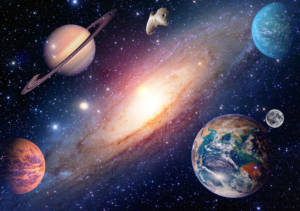
The outer planets of our Solar System hold just as many secrets and messages as our closer neighbors. See what can these giants tell us about our lives.
Astrology is big. A quick look at the internet reveals just how ingrained it is into our modern ethos and thought. While much of it focuses on the sun and closest celestial bodies, it discerns patterns and meanings from Jupiter, Saturn, Uranus, Neptune, and Pluto. Astrologers believe that these distant outer planets may provide some wisdom of their own.
An Introduction to the Outer Planets
The outer planets exhibit a wide range of physical compositions and environments: gas giants, ice giants, and one icy chunk of rock. These celestial objects represent the vital energies of their mythological counterparts. Since they take a long time to orbit our sun, their effects are seen by astrologers as generational and more long term.
Jupiter: A Jovial and Generous King
With its 12-year orbit around our sun, Jupiter has the shortest transits of any outer planet. This massive traveler inhabits each zodiac sign for around a year, but Cafe Astrology explains that it can retrograde for up to four months at a stretch. This regal celestial body governs generosity, optimism, honor, good fortune, ethics, and as the Astro Codex reveals, higher education. Since its effects in a sign can span for up to a year, they’re thought to impact everyone born during that same time period in similar ways.
Saturn: Growth, Discipline, and Legacies
Saturn makes a complete orbit around our sun in 29.5 years, taking around two and a half years to travel through each zodiac sign. Astrostyle discusses this titan’s key energies: time, maturity, structure, karma, discipline, and prestige. If you’ve heard the phrase “Saturn return,” you likely got the impression that it can signify life-changing events. As the Cut’s Claire Comstock-Gay clarifies, Saturn comes back to its original position in our natal charts during our late 20s, our late 50s, and our mid-to-late 80s. These all coincide with major life transitions or turning points during which we may reassess our life goals and make significant new plans.
Uranus: Technology, Enlightenment, and Innovation
Uranus is a weird planet for many reasons. It’s not just the only one named for a Greek deity instead of a Roman god, but it’s also the only one that rotates on its side. Christened after the primordial sky father, it takes 84 years to orbit our sun and seven years to pass through a zodiac sign. Cafe Astrology mentions that Uranus represents invention, innovation, intuitiveness, and individuality. Astrostyle also nicknames Uranus the “mad scientist” for its association with eccentricity.
Neptune: What Lies Beneath the Surface
Discovered in 1846, Neptune got its name from the Roman god of the sea. This planet completes one orbit around the sun in 165 years, which means that it makes a 14-year trip through each zodiac sign. As a result, those energies impact large generational groups. The Astro Codex mentions that Neptune governs spirituality, dreams, illusions, artistic creation, and even addiction.
Pluto: Secrets, Transformation, and Rebirth
Reclassified as a dwarf planet in 2006, Pluto represents the Roman ruler of the Underworld. Astrostyle comments that it governs the secrets we keep within ourselves, including sensitive matters such as money, shame, and sexuality, yet it also speaks to how we share or hoard our resources. As a symbol of transformation, it signifies intense and sometimes painful changes that end in positive results. Pluto takes around 30 years to move through each sign and 248 years to orbit the sun.
Since astrology is gaining greater traction in popular culture, it’s no surprise that many people have more than a passing curiosity about their planets and signs. Jupiter, Saturn, Uranus, Neptune, and Pluto all display extreme physical characteristics. Their astrological impacts are just as massive, affecting large cohorts of people as they complete their lengthy orbits.


